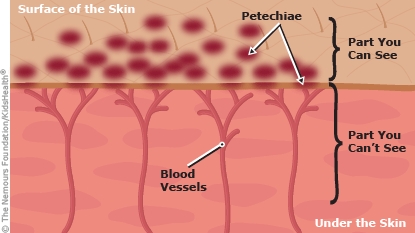Petechiae (peh-TEE-kee-eye) are pinpoint-size reddish-purple dots on the skin. They result from tiny spots of bleeding just under the skin and can show up on any part of the body. Most causes of petechiae are not serious and the dots usually go away on their own without special treatment.
Here's how to care for your child.



Your child:

Your child:

What causes petechiae? Petechiae happen when tiny blood vessels (called capillaries) in the skin break and bleed. There are many causes of petechiae and most are not serious. When someone coughs, cries, or vomits, the pressure in the blood vessels goes up and the tiny blood vessels can break. Rubbing, squeezing, or sucking on the skin can also break these tiny blood vessels. Petechiae can also be caused by certain medicines, infection from a virus or bacteria (types of germs), or an illness that causes your body to have less platelets (a type of blood cell that helps stop bleeding).
Why do healthcare providers sometimes do testing in someone with petechiae? Rarely, petechiae can be part of other illnesses. Healthcare providers may do testing to get more information.